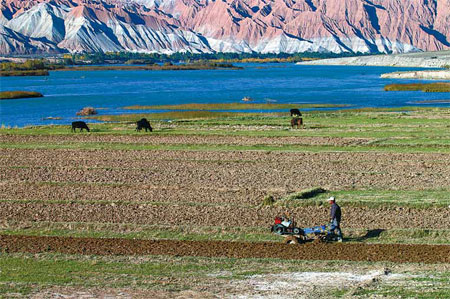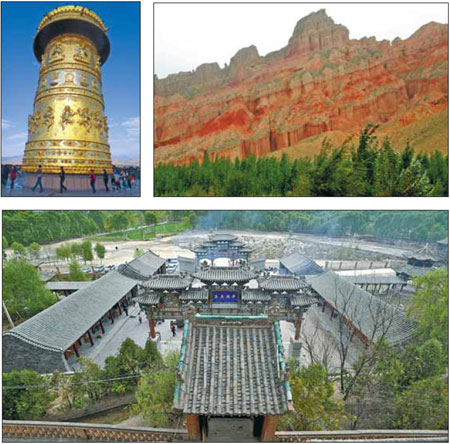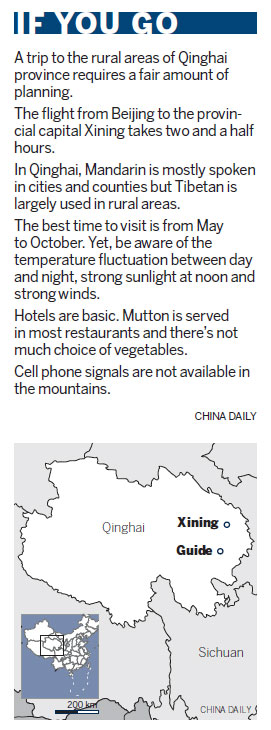Clear, blue Yellow River
Updated: 2012-07-05 10:00
By Chen Nan (China Daily)
|
||||||||

 |
|
Clockwise from top: Yellow River runs through Guide county in Qinghai province. The 4,000-meter high Laji Mountain is a picturesque site on the way from Qinghai's provincial capital Xining to Guide county. Both Han and Tibetan Buddhists worship at Wenchang Temple in Hexi village. A 42-meter-tall prayer wheel on the bank of Yellow River attracts many Buddhists. Li Quanju / for China Daily Chen Nan / China Daily Wang Jiacheng / for China Daily Li Quanju / for China Daily |
A trip to the source of the Yellow River in Qinghai is a revelation for reporter Chen Nan.
Before the Yellow River turns yellow - because of the silt it carries downstream, the river runs clear and blue, through the mountains on the northeastern part of the Tibetan Plateau, with an average elevation of more than 3,000 meters above sea level.
That's what I was told before my trip to the origin of the country's second longest river in Qinghai province - but I had my doubts.
"How clean is the Yellow River?" I ask Li Zhiqiang, who works with the local publicity office, on our way from Qinghai's provincial capital Xining to Guide county.
Li picks up a bottle of drinking water and says, "As clean as this."
Even so, I still had my doubts.
The 200 km ride is not easy. The unpaved one-lane road is bumpy and winding. One of the hardest parts is crossing the 4,000-meter high Laji Mountain, which took about three hours.
The government has invested in building a highway from Xining to Guide county, and an underground tunnel is also planned.
The landscape on either side of the road is pristine and unfolds like a scene from a postcard. Some hills are coated in lush greenery, dotted with herds of sheep and white tents. Far in the distance are snow-capped mountains towering into the blue sky. Even the black, slow-moving and hairy Tibetan yaks suit the scene.
In the valleys, young Tibetan women in pink headscarves sit on the ground, talking and laughing while working on handicrafts, while men drift by herding yaks.
When we arrive at Guide, a quiet town with a population of no more than 140,000, there is the Yellow River, clean, running fast and shining like gold in the midday sunlight.
"My hometown is known for the clean Yellow River waters," says our tour guide, Xiao Ma, 30.
Due to poverty and poor transport links, Guide is not a popular tourist destination.
Though Xiao Ma moved to Xining 10 years ago, she returns to Guide to visit her parents every year.
She was pregnant in 2011 but this did not stop her from making the journey home. "I had hoped my baby could experience the green vistas and the Yellow River even before he was born."

Qinghai province has a population of 5 million people, many of them from various ethnic groups. Besides Tibetans and Hans, there is also a sizable population of Mongolians, Hui and Tu people.
Since the end of 2011, the local government has been striving to develop tourism and has highlighted four sites to display the diverse cultures of its people.
At one site there is a huge, white, stone lotus on the southern bank of the Yellow River. Above the lotus stands a 42-meter-tall prayer wheel.
Costing nearly 40 million yuan ($6.3 million), the prayer wheel is recognized as the world's largest of its kind by Guinness World Records.
The 11th Panchen Lama Bainqen Erdini Qoigyijabu, a Living Buddha of Tibetan Buddhism, presided over the consecration ceremony of the prayer wheel in April.
Stepping onto the third floor, I am close enough to touch the prayer wheel and the gold foil-covered wheel, with images of Buddha carved on it.
A family - one man, two women and a couple of kids - stand near the prayer wheel turning the wheel.
Two Tibetan women, in long robes, having their hair braided, look at the prayer wheel for a while before turning it themselves.
I try to talk to them but none of them speak Mandarin. A monk, in red robes and short boots, says ni hao (hello) to us. His name is Sherab Nyima, 45, and is from a temple 100 km away in Guinan county, east of Guide county. He comes to see the prayer wheel every week.
"Many people, like me, come to see the wheel. It's the largest in the world," he says. "It has a connection with the Yellow River."
He also tells me that before the prayer wheel was set up, he often went to pray at the county's Wenchang Temple, which is my next destination.
With hada (white silk that denotes respect) flying on the pillars of the gate, the temple, nestled in the depth of mountains, looks solemn and ancient.
The temple was first built in the Ming Dynasty (1368-1644), for both the Han and Tibetan Buddhists but was destroyed in a fire. In 1982, the temple was rebuilt with donations from the residents of Hexi village.
Sunset arrives at around 8 pm and as darkness falls on the village, temperature begins to plummet - from 25 C in the day to 10 C at night.
We have dinner at a Muslim restaurant, which we are told is the best in Guide. Dishes like yak meat, mutton and noodle soup are served one after another. The tea tastes bitter, salty but pure. The waitress tells us to have mutton with garlic, which makes the mutton tastier.
The next day, we drive back onto the one-lane dirt road. Surprisingly, there are small snowflakes falling. Xiao Ma tells me that when the sun refracts off the glaciers, snowmelt trickles down the valleys.
The trip was like a gift, even though I didn't have time to visit Qinghai Lake, the country's largest salt-water lake. Still, this provides a good reason for another visit.

 'Taken 2' grabs movie box office crown
'Taken 2' grabs movie box office crown
 Rihanna's 'Diamonds' tops UK pop chart
Rihanna's 'Diamonds' tops UK pop chart
 Fans get look at vintage Rolling Stones
Fans get look at vintage Rolling Stones
 Celebrities attend Power of Women event
Celebrities attend Power of Women event
 Ang Lee breaks 'every rule' to make unlikely new Life of Pi film
Ang Lee breaks 'every rule' to make unlikely new Life of Pi film
 Rihanna almost thrown out of nightclub
Rihanna almost thrown out of nightclub
 'Dark Knight' wins weekend box office
'Dark Knight' wins weekend box office
 'Total Recall' stars gather in Beverly Hills
'Total Recall' stars gather in Beverly Hills
Most Viewed
Editor's Picks

|

|

|

|

|

|
Today's Top News
Health new priority for quake zone
Xi meets US top military officer
Japan's boats driven out of Diaoyu
China mulls online shopping legislation
Bird flu death toll rises to 22
Putin appoints new ambassador to China
Japanese ships blocked from Diaoyu Islands
Inspired by Guan, more Chinese pick up golf
US Weekly

|

|






